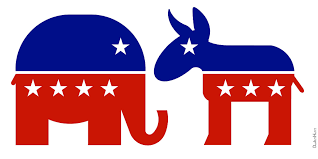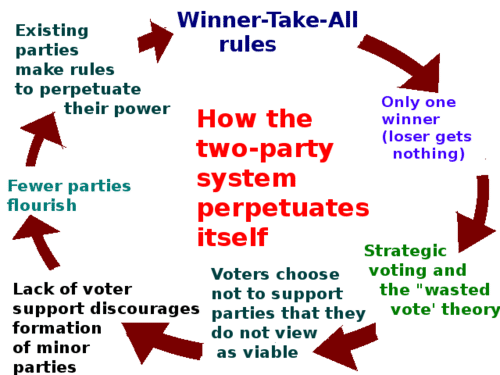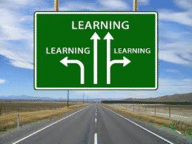6.6: Two- and Three-Party Systems
- Page ID
- 2015

It is easy to complain about petty bickering between Democrats and Republicans. What we sometimes forget is that Americans share a broad consensus, or agreement, of many basic political values. Both parties believe in liberty, equality, and individualism. Neither advocates that the Constitution be discarded. Both parties accept the election process and concede defeat to the winners. In many countries with multi-party systems, the range of beliefs is greater, and disagreements run deeper. For example, in modern day Russia, one party advocates a return to communism, some offer modified Socialism and/or Capitalism, and one promotes Ultra-Nationalism.
Video: The American Two-Party System Part 1
Historical Influence (Traditional):
The nation began with two political parties—the Federalists and the Democratic-Republicans. During early American history, politicians tended to take sides, starting with the debate over the Constitution, and continuing with the disagreements between two of George Washington's cabinet members—Alexander Hamilton and Thomas Jefferson. The tendency has persisted throughout American history.
The Winner-take-all System:
The single most important reason for a Two-Party System is the winner-take-all electoral system. In contrast to systems with proportional representation, the winner in American elections is the one who receives the largest number of votes. The winner does not need to have more than 50 percent, but only one vote more than his or her opponents. If a third party receives 15 percent of the vote for every contested Senate seat, that party wins zero seats in the United States Senate. Consequently, one of the two major parties almost always wins a plurality and third parties are completely shut out of national offices.
Even though political parties are often regarded as "necessary evils," they still play an important role in American government and politics today. The two broad-based major political parties offer alternatives to voters and help connect citizens to their government.
Video: Parties as a Linkage Institution
One of the reasons that the existence of political parties was inevitable from the beginnings of our governmental system (regardless of the warnings given by the Founding Fathers) is their role as linkage institutions, meaning they act as a mechanism to translate the concerns and desires of the people into law and policy. As linkage institutions, political parties help sift through the issues, identify the most important and most popular concerns, and then place these on the government agenda.
Picking Candidates: It is very rare for a candidate to get on the ballot and get elected without the endorsement (nomination) of a major political party. What many people don’t realize is that before the progressive movement of the early 20th century, most political parties selected their candidates without direct input from the public through meetings in smoke-filled back rooms in a very secret process. The official endorsement of a political party is called a nomination; this entitles the nominee a guaranteed listing on the general election ballot as the party’s candidate for a particular office.
Running Campaigns: In the past, national state and local party organizations were the prime mechanism for organizing and conducting political campaigns. With the rise of television, internet, and social media, it has become easier for a candidate to promote their own personal campaigns and take their campaign platform directly to the people with less help or influence from the political party organization.
Signaling Voters: Political parties often serve the same role as a brand name on a product you would purchase in a store. Just seeing the Democrat (D) or Republican (R) symbol next to a candidate’s name on a ballot gives important signals to the voter as to what the candidate stands for. But the party platforms can be incredibly extensive and a particular candidate may not agree with a specific stance on an issue (plank) that the party has placed in their platform. In this case, the candidate may either disassociate him/herself from the issue altogether or may make a personal statement in his/her individual platform that doesn’t agree with that of the party as a whole. This is why voters need to research the candidates on the ballot and NOT just rely on the party affiliation the candidate claims.
Policy Promotion: Each of the political parties will create a list of proposed policies and their specific position on a wide range of issues. This is called their platform. Each policy issue would be considered a plank in the platform. As an example, the Democratic Party platform advocates for women’s choice and accessibility of family planning and contraception issues whereas the Republican Party platform has repeatedly demanded restrictions and limitations in the same policy area.
Policy-making: As President Obama promotes a major policy goal, like health insurance coverage or higher education funding, he generally seeks the support of his fellow Democrats. This is a part of his role as the head of his party in government. Because the political process is so fragmented and full of disagreement and debate, political parties are necessary in order to coordinate the policymaking process between the executive branch and the legislative branch of government.
By now, it should be evident that political parties play a role in promoting debate and competition in the process of creating legislation and implementing policy. This is why, even though it was not included in the Constitution, and was not considered as a desirable part of our system of government by the Founding Fathers, the two-party system plays an essential role in American government today.

The two-party system has held a perpetual hold in American government because of the "horse race" mentality many voters put into elections (particularly national presidential elections). Since most states have a "winner-take-all" set of rules, there can only be one winner and all other candidates are "losers." The major parties (Democrats and Republicans), with the help of the media, give out signals to voters as to who is in the lead by way of political polls, media coverage, etc. As voters see a potential winner they often cast "strategic votes" for the candidates they believe will win an election. Votes for major party candidates are considered much more effective than votes for third-party candidates they feel may not win anyway. Since voters don't see most third party candidates as viable, they don't support minor parties. Without popular support, minor parties have difficulty forming and maintaining a base of voters. In addition, the major parties, through their official roles in government, have the ability to make rules that give advantages to the major parties (such as automatically getting on the ballot vs. having to get signatures in every state).
While the story of political parties in the United States is primarily a study of the two major parties and the two-party system, third parties have been a regular feature on the political scene as well. There are three basic types of third parties in the United States system of government (Edwards P. 266):
Ideological Parties – tend to promote a single cause or a group of related and specific causes. These can surround a specific controversial issue (such as gun rights, women’s choice, same sex marriage/gay rights and the legalization of drugs are examples of such controversial issues today. But they can also promote relative extreme ideological positions such as the libertarians or the tea party who tend to gravitate around issues involving States rights, personal liberties and the role of the national government.
Splinter Parties - are offshoots of a major party. For example, Teddy Roosevelt’s Progressives were a splinter of the Republican Party in 1912 and Strom Thurmond’s States’ Righters (1948), as well as George Wallace’s American Independents, were splintered from a conservative group of Democratic party members in the south.
Candidate-aligned parties – tend to form when a specific candidate has aspirations for higher office (such as the presidency) yet have little chance of obtaining the nomination of a major party. Examples would include John Anderson in 1980 and Ross Perot in 1992 and 1996 who offered voters that claimed to be dissatisfied with both the Republicans and the Democrats with a “moderate” third party choice that offered a platform that was appealing with conservative Democrats and moderate Republicans.
Video: Does Washington Need Third-Parties?
While third parties have popped up on the political scene from time to time, most third party candidates do not win office. Yet many political analysts believe they are still quite important. This is because they have often served as “safety valves” for those who are unhappy with both of the major parties and are seeking an alternative (Rosenstone).
If the United States had a truly multiparty system (like much of Europe), which accommodated a variety of third-party choices, would it really make that much of a difference? Many political scholars would argue “yes,” because the more political party choices are available on a ballot, the more confusing and fractured the political spectrum becomes. If the United States had a large number of political parties vying for attention, each would have to make a special appeal to the public in order to differentiate itself. In such a political environment it would not be surprising to see political parties representing the interests of minorities (like African Americans and Latinos) or ideological issues (such as Environmentalism) or religious issues (such as the “moral majority”) or other issues like gun rights, women’s rights, marijuana legalization, immigration rights, etc. As all of these parties compete for attention, the political field would become crowded and full of “static,” which would make it hard to arrive at decisions that would benefit the public interest. This phenomenon is referred to as hyperpluralism and can be compared to the old adage “too many cooks in the kitchen spoil the broth.”
The two-party system in the United States contributes to a level of “ambiguity” in policy alternatives, meaning that political parties are not as apt to take a risk in standing behind a particularly controversial issue if it means that it would lessen their candidate’s chances of getting elected to office. For this reason, many of the issues and positions of the major political parties tend to gravitate towards a more moderate or middle position between a far-left liberal stance that many Democrats would prefer to take and a far right conservative stance that many Republicans would favor.
Benefits of Third Parties:
- Third parties have forced major parties to deal with issues they wanted to ignore
- Many third parties have represented ignored groups in society and have raised otherwise ignored issues
- Third parties help keep the other two parties “on their toes.”
- Third parties often act as a safety valve in our political system.
Reasons Third Parties Have Not Been Successful:
- Many see them as not being a viable party – why waste their vote?
- Many of the issues supported or introduced by third parties are not popular with a majority of Americans.
- The larger parties steal issues from them.
- Ex: Ross Perot and the balanced budget.
- Many third parties have a “radical Image” – They are always having to fight a distorted image within the public.
- Third parties often serve the role of a “spoiler” – meaning they simply take votes away from one of the major parties and cause the other party to win an election (as in the case of the 2000 Bush v. Gore election where Ralph Nader and the Green Party took votes away from the Democrats who primarily agreed with them on most of the issues).
- Third parties are resource-poor in comparison to their major two-party counterparts.
- Lack of Media Coverage – Much of the media often sees a third-party candidate as “frivolous.”
- Often, the issues introduced or supported by third-parties are too narrow and don’t affect a wider audience.
- Election Rules have been deliberately written to make it difficult for third parties to get their candidates on the ballot.

Study/Discussion Questions
- Explain the factors enabling the two-party system in the United States.
- Investigate how political parties serve as linkage institutions to connect the people to their elected officials.
- Describe the role of political parties in the two-party system.
- Summarize the factors leading to the perpetuation of two-party politics in the United States.
5. According to the text, what are the three basic types of third parties in the United States?
6. Why do many political scholars today believe third parties are relevant and important in today's political environment?
7. Why do you think third parties are successful in other places in the world but not in the United States?
8. What is hyperpluralism and why is it a problem today?
9. What is a "spoiler"? Why are these types of candidates a problem?
10. Do you believe third parties are important in our government today? Explain your answer.
11.. Research at least one third party and its platform, and find the following information for your chosen party:
Name of party
Origins of party
Major party candidates
Platform and platform plan has perpetuated itself over the life of our country with little if any room for viable third party alternatives.
- Many third-parties have represented ignored groups in society and have raised otherwise ignored issues
- Third parties help keep the other two parties “on their toes.”
- Third parties often act as a safety valve in our political system.

